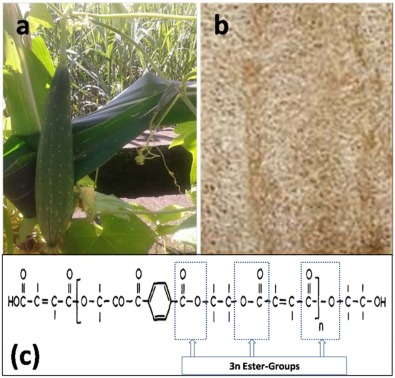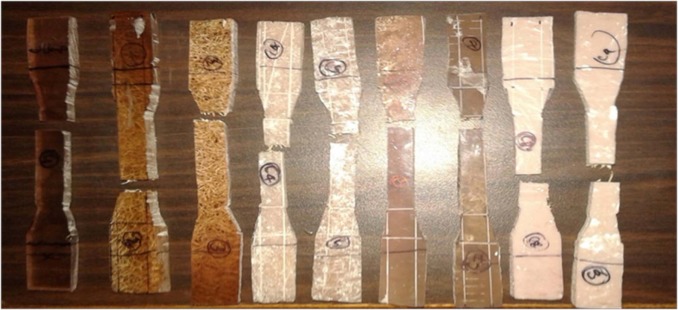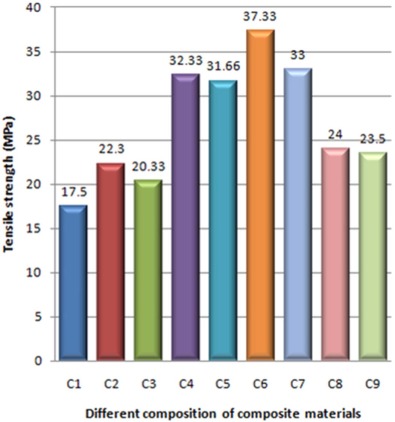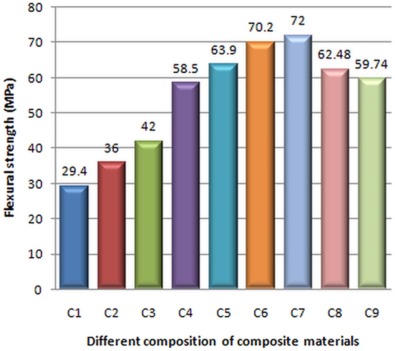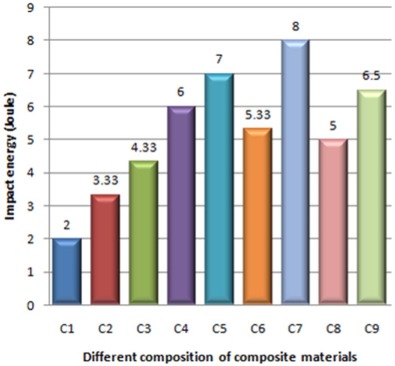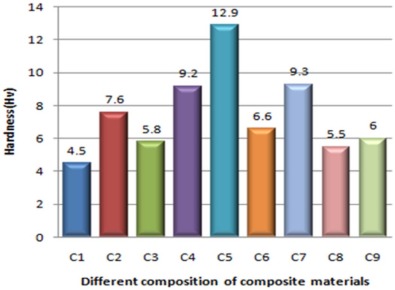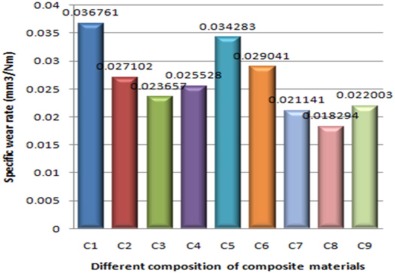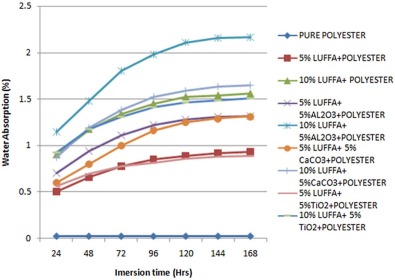Abstract
The development of natural fibre reinforced polymer composites has gained popularity in many applications due to their environment friendly characteristics over the synthetic fibre based polymer composites. This paper describes the fabrication and physical, mechanical, three-body abrasive wear and water absorption behaviour of Luffa fibre reinforced polyester composites with and without addition of micro-fillers of Al2 O3 , CaCO3 and TiO2 . The ranking of the composite materials has been made by using Technique for order preference by similarity to ideal solution (TOPSIS) method with output parameters of their physical, mechanical and abrasive wear and water absorption attributes. The addition of microfillers has enhanced greatly the physical and mechanical properties of Luffa -fibre based composites. The addition of microfillers has influenced the physico-mechanical properties of Luffa -fibre based polyester composites in descending order of CaCO3 , Al2 O3 , and TiO2 .
Keywords
Luffa cylindrica ; Composites ; Polymer composites ; Hybrid composites
1. Introduction
Over the past few decades, remarkable interest has been observed in natural fibre as a substitute for glass and ceramic owing to its eco-friendly and renewable nature, low cost, lightweight, high specific mechanical performance, etc. Natural fibres such as kenaf [1] , bagasse [2] , jute [3] , [4] , [5] , [6] , [7] and [8] , ramie, oil palm [9] and hemp [10] have been investigated as reinforcements for the fabrication of fibre-reinforced polymer composites. Natural fibres can be used as alternatives of synthetic fibres, e.g. aramid, glass, carbon, etc. [11] . Natural fibre based polymer composites have found application in furniture, packaging, acoustics vibration isolation, impact energy absorption, building, automobile industries, aeronautics, and naval application [12] , [13] , [14] , [15] , [16] and [17] . The fruit of sponge guard (Luffa cylindrica ) belongs to Cucurbitaceous family [18] and is naturally available in many countries. The young cylindrical Luffa fruit is edible and contains many compounds such as phenolics, lavonoids, triterpenoids and ribosome-inactivating protein. Luffa fruit has been effectively utilized for medicinal purposes such as immune-stimulatory and anti-inflammatory agent [19] . Luffa sponge is a suitable natural fibre and has been successfully utilized in the process of bio-sorption of heavy metals from waste water. This emerging cash crop has full potential to improve the economy of developing nation. Luffa cylindrica is available in mat form naturally [18] , [19] , [20] and [21] . The Luffa fibres contain 84% holocellulose, 66% cellulose, 17% hemi-cellulose, 15% legnin, 3.2% extractives, and 0.4% ashes [22] . The physical properties of Luffa fibre are of density 820 kg/m3 , diameter 25–60 µm, and crystallinity index 59.1 [19] , [22] , [23] and [24] . Oboh et al. [18] demonstrated the capabilities and applications of Luffa fibres in medicine, agriculture, and science and technology. Msahli et al. [25] investigated that flexural strength and adhesion between Luffa fibre and polyester matrix was improved by acetylating and cyanoethylating treatments of Luffa fibres. Srinivasan et al. [26] investigated that mechanical properties of Luffa fibre epoxy composites filled with SiO2 nanoparticles increased by 2% than unfilled Luffa fibre epoxy composites.
TOPSIS method is a powerful Multiple-Attribute Decision Making technique for selecting the best alternatives from number of possible alternatives. According to this the best alternative would be the one that is closest to the positive ideal solution and farthest from the negative ideal (hypothetically worst) solution. The main aim of TOPSIS is to select the top ranked alternative and compare it with all ranks in this set of simulations. TOPSIS method has been standardized as a multi-criteria decision making tool in a much wider horizon of applications such as Supply Chain Management and Logistics, Design, Engineering and Manufacturing Systems, Business and Marketing Management, Health, Safety and Environment Management, Human Resources Management, Energy Management, Chemical Engineering, Water Resources Management and others as nicely reviewed by analysing 266 scholary papers from 2000 to 2012 [27] . In Design, Engineering and Manufacturing Systems, TOPSIS provided the best possible solution to seventy-two different applications in materials, manufacturing, machatronics, robotics, automobiles, aviation, energy and power, engineering design. Etc. [27] . TOPSIS has been explored as a useful tool in the selection of subsystems for a composite product development in order of preference for a given application [28] and [29] . For composites, the TOPSIS method can be effectively applied for determining the ranking based on the relative importance/weightage of one or more physical/chemical/mechanical properties according to the service requirements or products' qualities. In this work all the composite materials have been compared using TOPSIS method and ranking has been done accordingly. The decision matrix, normalization matrix, weight normalized matrix, ideal positive and ideal negative solution, separation measure, relative closeness value and ranking are tabulated in Table 4 , Table 5 , Table 6 , Table 7 , Table 8 and Table 9 respectively.
The incorporation of filler into polymer has proved to be an alternative for the improvement of the performance of the resultant composites. Hybridization of fibres with fillers has been used to enhance the properties of composites. A judicious selection of matrix and the reinforcing phase can lead to a composite with a combination of strength and modulus comparable to or even better than those of conventional metallic materials. The improved performance of polymers and their composites in industrial and structural applications by the addition of particulate filler materials has shown a great promise and so has lately been a subject of considerable interest. Specific fillers (additives) are added to enhance and modify the quality of composites. Mechanical properties are reckoned as the most important of all the physical and chemical properties in majority of applications [30] . The plastics/polymers should be able to sustain high tensile loading, impact loading, fatigue loading, etc. and offer high resistance to wear, abrasion, etc. in order to achieve a widespread applicability as well as economical and lightweight alternatives of ferrous and non-ferrous materials. Tensile strength is one of the most widely measured mechanical properties of composites utilized in structural applications. Fibre reinforcement enabled a good combination of properties to polymer composites finding wide usefulness in structural and automotives components applications [31] . The car manufacturers fabricated non-structural components using hemp and flax fibres owing to their higher specific strength and lower cost compared to conventional reinforcements [32] . The natural fibres are eco-friendly; most economically sustainable resources are available abundantly in nature and are exploited selectively and wisely in the development of high performance polymer composites. Therefore, it has been the prime motives of many materialists and researchers to develop polymeric composites with high mechanical properties by suitable selection of fibres and their chemical modifications, resin compounds and hybrid fillers in a most economical way. In recent years, studies have been made about the fabrication and physical/chemical/mechanical characterization of plain and chemically treated luffa fibres based polymer composites. Demir et al. treated Luffa fibres by three different coupling agents namely (3-aminopropyl)-triethoxysilane (AS), 3-(trimethoxysilyl)-1-propanethiol (MS), and maleic anhydride grafted polypropylene (MAPP) and demonstrated better mechanical properties with MS-treated Luffa fibre based polypropylene composites owing to better adhesion between matrix and fibres [33] . Recently, the effect of chemical (2% NaOH/1–3% Methacrylamide) treatments of Luffa cylindrica on physico-mechanical properties of polyester composites were investigated [34] . In a novel value addition to Luffa cylindrica /Polyester composites, an attempt has been made to identify one or more selective micro-additives for developing high performance polymer composites with enhanced physico-mechanical properties. In the present work, the effect of different micro-additives such as Al2 O3 , CaCO3 and TiO2 has been investigated on the physico-mechanical, three body abrasive wear and water absorption behaviour of Luffa fibre reinforced polyester composites. Finally, the ranking of as fabricated polymer composites has been made by TOPSIS method on the basis of their physical, mechanical and abrasive wear and water absorption attributes.
2. Experimental details
2.1. Materials
Luffa fruits (shown in Fig. 1a ) were collected locally from the hilly terrain of Pauri-Garhwal, India and further treated with water for 24 hours in order to remove wax, lignin and oil from the external surface of Luffa fibres and then dried at room temperature. After drying under Sun-bath for a few days, a fibrous mat was cut from the outer core of Luffa fruit-shell which was further placed between two flat wooden plates and straightened to uniform thickness by applying uniform compressive load with mechanical Bench Vice for a few hours. Finally a fibrous mat of dimension (290 mm × 200 mm) was cut as shown in Fig. 1b . Al2 O3 , CaCO3 and TiO2 were taken as micro particulate fillers and unsaturated pure polyester was taken as a matrix material. Micro particulate fillers (Al2 O3 , CaCO3 and TiO2 ) were procured from Kalindi Medicure Pvt. Ltd, Dehradun India and Intelligent Materials Pvt Ltd, Chandigarh, India. Unsaturated Polyester (Isophthalic) resin was obtained from Amtech Esters Pvt. Ltd. New Delhi, India. The chemical structure of isophthalic polyester resin is shown in Fig. 1c[35] .
|
|
|
Fig. 1. The image of (a) Luffa cylindrica Fruit, (b) rectangular portion of Luffa fibre, (c) chemical structure of isophthalic polyester resin. |
2.2. Composite fabrication
Fabrication of composite was done by a conventional method called hand lay-up method. Hand lay-up method has been a widely explored technique of fabricating natural fibre based composites owing to its simplicity, cost effectiveness and flexibility, which is economically suitable to developing countries and less financially supported Universities and Colleges. A nice review on characterization of natural fibre and composites has been made by Satishkumar et al. where lots of natural fibre based composites were prepared by hand lay-up method [36] . A wooden mould of dimension 300 × 210 × 20 mm3 was used. Al2 O3 , CaCO3 and TiO2 microfillers were mixed carefully and mechanically stirred in a plastic jar according to composition of composites with polyester resin, hardener and accelerator in the ratio of 100:1.5:1.5 by weight [37] and [38] . For quick and easy removal of composites, a mould release sheet was put over the wooden mould and a mould release spray was applied at the inner surface of the mould. After keeping the mould on a ply-board, a thin layer of the mixture was poured followed by distribution of fibre lamina onto the mixture. The resin was applied over the fibre laminate, and the procedure was repeated to get the desired thickness. The remainder of the mixture was poured into the mould. Immediately after pouring the resin mixture in the mould, the resin-containing mould was placed in desiccators and degassed by using a suction pump, allowing the air bubbles formed during processing to escape. A load of 25 kg was applied from the top and the mould was allowed to preserve at room temperature for 24 hours. After 24 hours, the samples were taken out of the mould and were cut into required size for mechanical, wear and water absorption tests by a wire hacksaw blade. The detail designation and composition of composites are given in Table 1 .
| S. No. | Designation | Compositions |
|---|---|---|
| 1 | C1 | Polyester + Luffa fibre (0 wt%) |
| 2 | C2 | Polyester + Luffa fibre (5 wt%) |
| 3 | C3 | Polyester + Luffa fibre (10 wt%) |
| 4 | C4 | Polyester + Luffa fibre (5 wt%) + Al2 O3 (5 wt%) |
| 5 | C5 | Polyester + Luffa fibre (10 wt%) + Al2 O3 (5 wt%) |
| 6 | C6 | Polyester + Luffa fibre (5 wt%) + CaCO3 (5 wt%) |
| 7 | C7 | Polyester + Luffa fibre (10 wt%) + CaCO3 (5 wt%) |
| 8 | C8 | Polyester + Luffa fibre (5 wt%) + TiO2 (5 wt%) |
| 9 | C9 | Polyester + Luffa fibre (10 wt%) + TiO2 (5 wt%) |
3. Characterizations of composite materials
3.1. Physical testing
The composites under this investigation consists of mainly three constituents, namely, matrix, Luffa fibre, and micro fillers. The theoretical density of composites in terms of weight fraction can easily be obtained as per Equation (1)[39] and [40]
|
|
( 1) |
where, W and ρ designate the weight fraction and density respectively. The suffix f, m, p and ct represent the fibre, matrix, particulate and the composite theoretical, respectively.
The experimental density (ρce ) of the composite, however, can be determined experimentally by simple water-immersion technique [40] . The volume fraction of voids (Vv ) in the composites is calculated using Equation (2)[39] and [40]
|
|
( 2) |
3.2. Mechanical testing
Tensile tests were conducted on computerized Universal Testing Machine HEICO (HL-590) with a cross-head speed of 10 mm/min. The tensile test samples were prepared according to ASTM: D303 standard and shape of samples were like dog-bone. Specimens of various composites after tensile test are shown in Fig. 2 . Three points flexural test specimens were performed on the same machine at cross-head speed of 10 mm/min according to ASTM: D790 with dimension of 140 × 15 × 5 mm. Impact test specimens were cut according to ASTM: E23 to measure the impact strength. The specimens were prepared with the dimension of 55 × 10 × 10 mm and the depth of the notch was 3.33 mm (t/3 mm) with 45o angle. The samples were fractured in Charpy impact testing machine and the energy (joule) absorbed while being broken was observed. Computerized Vickers Hardness Tester was used to measure the hardness of composite specimens under the ASTM E92 standards. A diamond intender with an apical angle of 136° was intended over the surface of the specimen under a load of 1 kg for 15 second.
|
|
|
Fig. 2. Tensile tested specimens of various composites. |
3.3. Three body abrasive wear test
The three-body abrasive wear tests were performed on dry sand rubber/wheel abrasion tester as per ASTM G 65 test standards. This test was performed by keeping these parameters constant (i.e. normal load: 67 N sliding distance: 1046.15 m, abrasive size: 100 µm, wheel speed: 150 rpm and counter: 1500). Fig. 3 shows the abraded composite samples with and without fillers.
|
|
|
Fig. 3. Abraded specimens of various composites. |
3.4. Water absorption test
Moisture absorption studies were performed as per ASTM D 570-98 standards and sample size was two inch diameter disks, 0.125″ or 0.250″ thick. The weight of the samples was taken before subjecting them to normal water. After exposure for 24 hours, the specimens were taken out from the moist environment and all surface moisture was removed with a clean dry cloth or tissue paper. The specimens were reweighed to the nearest 0.001 mg by electronic digital balance within 1 min of removing them from the environment chamber. The specimens were weighed regularly at 24, 48, 72, 96, 120, 144 and 168 hours exposure. The ratio of increase in mass of the specimen to the initial mass gives the percentage moisture absorption.
4. Results and discussion
4.1. Physical properties
The theoretical and measured density of composite samples with their void volume fraction is presented in Table 2 . The differences in theoretical and experimental densities are the measure of voids present in composite samples. It is difficult to avoid the formation of voids in the composites fabricated by the hand layup technique, but maximum possible measures were taken to minimize the formation of these voids during the fabrication of the composites. It is necessary to determine the void content of the composites as it affects the property of the material. Table 2 reveals that the void fraction in the composites increases with the fibre loading. The natural fibres consist of lumens in its cellular structure which acts as void. It means such fibre carries these voids naturally. Thus, it agrees with the reason of increase in void content with the increase in fibre loading [41] . A similar trend is also observed by previous researchers [42] and [43] . It is also noticed that composite C5 contains the highest void fraction than other composites. The highest volume fraction of voids associated with alumina filled Luffa/Polyester composites may be attributed to its poorer bonding with resin matrix owing to its much higher ceramic nature compared to TiO2 and CaCO3 . In an earlier investigation of reinforcing of treated and untreated Al2 O3 in unsaturated polyester composites, the untreated Al2 O3 nano/micro-particles exhibited poorer bonding with unsaturated polyester resin and on the counterpart the organo-functional silane treated Al2 O3 exhibited enhanced bonding strength with unsaturated polyester [44] . It can be interpreted from Table 2 that by increasing the load wt% of Luffa fibre from 5% to 10%, the volume fraction of voids increases, which may be attributed to the increased volume fraction of lumens in the cellular structure of Luffa fibre and poor wetting of high content Luffa fibre with resin matrix. A similar trend was also observed with increasing load wt% of microadditive from 5% to 10% of each Al2 O3 , CaCO3 and TiO2 ; however the volume fraction of voids of plain10 wt% Luffa cylindrica /Polyester composites got substantially decreased from 4.9% to 2.1% with CaCO3 and 3.3% withTiO2 microadditive. From this observation, CaCO3 and TiO2 may be envisaged to enhance the wettability of fibres with matrix and/or occupying some microscale voids formed due to poor wettability of fibres and unavoidable voids formation associated with hand lay-up technique.
| Composites | Theoretical density (gm/cm3 ) | Experimental density (gm/cm3 ) | Volume fraction of voids (%) |
|---|---|---|---|
| C1 | 1.20 | 1.189 | 0.91 |
| C2 | 1.174 | 1.156 | 1.5 |
| C3 | 1.151 | 1.094 | 4.9 |
| C4 | 1.212 | 1.144 | 5.6 |
| C5 | 1.188 | 1.085 | 8.6 |
| C6 | 1.205 | 1.187 | 1.4 |
| C7 | 1.181 | 1.156 | 2.1 |
| C8 | 1.213 | 1.194 | 1.5 |
| C9 | 1.189 | 1.149 | 3.3 |
4.2. Mechanical properties
4.2.1. Tensile strength
Fig. 4 shows the effect of fibre loading on both with and without micro-fillers in Luffa fibre reinforced composites. It can be clearly observed that the tensile strength of the composites decreases with the increase in fibre loading in both cases, i.e. with and without micro-fillers. This may be due to the poor adhesion between fibre and matrix, but the addition of different microfillers (Al2 O3 , CaCO3 and TiO2 ) influences the tensile strength of composites. This may be due to good particle dispersion and strong polymer/filler interface adhesion for effective stress transfer. From the obtained results, the composite C6 exhibited maximum ultimate strength (37.33 MPa) compared to other filled and unfilled composites.
|
|
|
Fig. 4. Effect of different composition of composite materials on tensile strength. |
4.2.2. Flexural strength
Comparison of the flexural strengths of composite materials is shown in Fig. 5 . It is clearly indicated that composites C7 exhibited maximum flexural strength (72 MPa) when compared with other filled and unfilled composites. This may be due to good compatibility between filler and matrix. It is also noticed that flexural strength of composites increases with the increase in fibre loading except composites C8 and C9 filled with TiO2 . The addition of different fillers (Al2 O3 , CaCO3 and TiO2 ) in different fibre loading of Luffa fibre composites affects the flexural strength of composites due to uniform distribution of filler materials and increased effective bonding between filler materials and matrix and strong polymer/filler interface adhesion.
|
|
|
Fig. 5. Effect of different composition of composite materials on flexural strength. |
4.2.3. Impact strength
The effect of fibre content on the impact strength is shown in Fig. 6 . It is observed from the figure that the addition of fibre and fillers in the matrix leads to improved impact strength of the composites. The impact strength increases with the increase in the fibre loading of the composites. In case of composites with higher fibre content the chance of fibre pull-out is greater. As the fibre content in composites increases, more energy will be required for the weakening of the fibre matrix bonding; in other words more energy will be absorbed by the fibres. From the figure, it is clearly indicated that composites C7 exhibited maximum impact strength (8 joules) when compared with other filled and unfilled composites. The good bonding strength between microfillers, matrix and fibre and flexibility of the interface molecular results in absorbing and dispersing more energy, and prevents the early initiation of cracks more effectively.
|
|
|
Fig. 6. Effect of different composition of composite materials on impact strength. |
4.2.4. Hardness test
Vickers hardness test has been conducted on the composite samples. Fig. 7 depicts that the hardness value of fillers filled composites increases with increase in fibre weight percentage but in the case of unfilled composites it decreases. The experimental results indicated in Fig. 7 reveals that the composite C5 has exhibited maximum hardness number (12.9 HVN). This may be due to uniform dispersion of Al2 O3 particles and decrease in inter particle distance in the matrix which results in increase of resistance of composites against indentation. The filler filled composites exhibits better hardness compared to the unfilled composites.
|
|
|
Fig. 7. Effect of different composition of composite materials on hardness. |
4.3. Three body abrasive test
Fig. 8 displays the effect of different composition of composite materials on the specific wear rate of composites keeping parameters constant (i.e. normal load: 67 N, sliding distance: 1046.15 m, abrasive size: 100 µm, wheel speed: 150 rpm and counter: 1500, shown in Table 3 ). It is observed from the figure that in composites filled with Al2 O3 and TiO2 , the specific wear rate of composites increases with increase in fibre loading whereas in CaCO3 filled and unfilled composites it decreases with increase in fibre loading. Composite C5 exhibited maximum specific wear rate which can be due to presence of maximum (8.6%) volume fraction of voids. The composite C8 exhibited minimum specific wear rate owing to its low (1.5%) volume fraction of voids.
|
|
|
Fig. 8. Effect of different composition of composite materials on specific wear rate. |
| Composites | Initial wt. of work piece (gm) | Final wt. of work piece (gm) | Loss of wt. (gm) | Specific wear rate (mm3 /Nm) |
|---|---|---|---|---|
| C1 | 18.987 | 16.029 | 2.958 | 0.036761 |
| C2 | 17.925 | 15.729 | 2.196 | 0.027102 |
| C3 | 14.830 | 13.016 | 1.814 | 0.023657 |
| C4 | 14.877 | 12.830 | 2.047 | 0.025528 |
| C5 | 13.498 | 10.922 | 2.576 | 0.034283 |
| C6 | 19.354 | 16.893 | 2.461 | 0.029041 |
| C7 | 17.923 | 16.210 | 1.713 | 0.021141 |
| C8 | 15.147 | 13.616 | 1.531 | 0.018294 |
| C9 | 16.665 | 14.893 | 1.772 | 0.022003 |
4.4. Water absorption test
Water absorption test is very important to determine the water absorptivity of the composite materials [45] . The effect of fibre loading on the water absorption of the filled and unfilled Luffa -fibre reinforced composites with increase in immersion time is shown in Fig. 9 . It is evident from the figure that the rate of moisture absorption increases with increase in fibre loading. Generally, the rate of water absorption is greatly influenced by the materials density and void content. It is clearly seen in the figure that 10 wt% of fibre loading results in higher water absorption rate as compared to 5 wt% fibre loading in both unfilled and filled composites. The reason may be explained from earlier observations that the Luffa fibres contain abundant polar hydroxide groups, which result in a high moisture absorption level of natural fibre reinforced polymer matrix composites and are a major obstacle for preventing extensive applications of these materials [46] . The minimum water absorption rate is observed for composite C8 with 5 wt% of fibre loading filled with TiO2 microfiller. It is also observed from the figure that the water absorption rate generally increases with immersion time, reaching a certain value at a saturation point where no more water is absorbed. The maximum weight gain from 0.89% to 2.16% (weight fraction) is observed by the composite specimens at room temperature.
|
|
|
Fig. 9. Effect of immersion time on water absorption properties of composites. |
4.5. Ranking of materials using TOPSIS method
TOPSIS method is a powerful technique for selecting the best alternatives from number of possible alternatives. According to this the best alternative would be the one that is closest to the positive-ideal solution and farthest from the negative ideal solution. The main aim of TOPSIS is to select the top ranked alternative and compare it with all ranks in this set of simulations. All the composite materials have been compared using TOPSIS method and ranking has been done accordingly. The decision matrix, normalization matrix, weight normalized matrix, ideal positive and ideal negative solution, separation measure, relative closeness value and ranking are tabulated in Table 4 , Table 5 , Table 6 , Table 7 , Table 8 and Table 9 respectively.
| Composites | Density (gm/cm3 ) | Tensile strength (MPa) | Flexural strength (MPa) | Impact strength (joule) | Hardness (Hv) | Specific wear rate (mm3 /Nm) | Water absorption (%) |
|---|---|---|---|---|---|---|---|
| C1 | 1.189 | 17.5 | 29.4 | 2 | 4.5 | 0.036761 | 0.0288 |
| C2 | 1.156 | 22.3 | 36 | 3.33 | 7.6 | 0.027102 | 0.9371 |
| C3 | 1.094 | 20.33 | 42 | 4.33 | 5.8 | 0.023657 | 1.5614 |
| C4 | 1.144 | 32.33 | 58.5 | 6 | 9.2 | 0.025528 | 1.3216 |
| C5 | 1.085 | 31.66 | 63.9 | 7 | 12.9 | 0.034283 | 2.1698 |
| C6 | 1.187 | 37.33 | 70.2 | 5.33 | 6.6 | 0.029041 | 1.3155 |
| C7 | 1.156 | 33 | 72 | 8 | 9.3 | 0.021141 | 1.6503 |
| C8 | 1.194 | 24 | 62.48 | 5 | 5.5 | 0.018294 | 0.8921 |
| C9 | 1.149 | 23.5 | 59.74 | 6.5 | 6 | 0.022003 | 1.5106 |
| Composites | Density (gm/cm3 ) | Tensile strength (MPa) | Flexural strength (MPa) | Impact strength (joule) | Hardness (Hv) | Specific wear rate (mm3 /Nm) | Water absorption (%) |
|---|---|---|---|---|---|---|---|
| C1 | 0.3443 | 0.2110 | 0.1725 | 0.1198 | 0.1903 | 0.4531 | 0.0069 |
| C2 | 0.3347 | 0.2689 | 0.2113 | 0.1995 | 0.3214 | 0.3340 | 0.2252 |
| C3 | 0.3168 | 0.2451 | 0.2465 | 0.2594 | 0.2453 | 0.2916 | 0.3753 |
| C4 | 0.3312 | 0.3899 | 0.3434 | 0.3595 | 0.3891 | 0.3146 | 0.3177 |
| C5 | 0.3142 | 0.3818 | 0.3751 | 0.4194 | 0.5456 | 0.4225 | 0.5216 |
| C6 | 0.3437 | 0.4502 | 0.4121 | 0.3193 | 0.2791 | 0.3579 | 0.3162 |
| C7 | 0.3347 | 0.3979 | 0.4226 | 0.4793 | 0.3933 | 0.2605 | 0.3967 |
| C8 | 0.3457 | 0.2894 | 0.3668 | 0.2996 | 0.2326 | 0.2254 | 0.2144 |
| C9 | 0.3327 | 0.2834 | 0.3507 | 0.3894 | 0.2537 | 0.2712 | 0.3631 |
| Composites | Density (gm/cm3 ) | Tensile strength (MPa) | Flexural strength (MPa) | Impact strength (joule) | Hardness (Hv) | Specific wear rate (mm3 /Nm) | Water absorption (%) |
|---|---|---|---|---|---|---|---|
| C1 | 0.049185 | 0.030142 | 0.024643 | 0.017114 | 0.027186 | 0.064729 | 0.000986 |
| C2 | 0.047814 | 0.038414 | 0.030186 | 0.0285 | 0.045914 | 0.047714 | 0.032171 |
| C3 | 0.045257 | 0.035014 | 0.035214 | 0.037057 | 0.035043 | 0.041657 | 0.053614 |
| C4 | 0.047314 | 0.0557 | 0.049057 | 0.051357 | 0.055586 | 0.044943 | 0.045386 |
| C5 | 0.044885 | 0.054543 | 0.053586 | 0.059914 | 0.077943 | 0.060357 | 0.074514 |
| C6 | 0.04910 | 0.064314 | 0.058871 | 0.045614 | 0.039871 | 0.051129 | 0.045171 |
| C7 | 0.047814 | 0.056843 | 0.060371 | 0.068471 | 0.056186 | 0.037214 | 0.056671 |
| C8 | 0.049385 | 0.041343 | 0.0524 | 0.0428 | 0.033229 | 0.0322 | 0.030629 |
| C9 | 0.047528 | 0.040486 | 0.0501 | 0.055629 | 0.036243 | 0.038743 | 0.051871 |
| Solution | Density (gm/cm3 ) | Tensile strength (MPa) | Flexural strength (MPa) | Impact strength (joule) | Hardness (Hv) | Specific wear rate (mm3 /Nm) | Water absorption (%) |
|---|---|---|---|---|---|---|---|
| A+ (Positive ideal solution) | 0.044885 | 0.064314 | 0.060371 | 0.068471 | 0.077943 | 0.0322 | 0.000986 |
| A- (negative ideal solution) | 0.049385 | 0.030142 | 0.024643 | 0.017114 | 0.027186 | 0.064729 | 0.074514 |
| Composites | S+ | S- |
|---|---|---|
| C1 | 0.093459 | 0.073528 |
| C2 | 0.073669 | 0.051618 |
| C3 | 0.084722 | 0.039763 |
| C4 | 0.055987 | 0.066877 |
| C5 | 0.080086 | 0.076684 |
| C6 | 0.065593 | 0.066018 |
| C7 | 0.060528 | 0.080906 |
| C8 | 0.064408 | 0.067647 |
| C9 | 0.07222 | 0.059261 |
Finally the ranking of filled and unfilled composites based on their properties has been shown in Table 9 . It has been clearly observed that ranking of composite materials are as follows: Rank 1 (C7: Polyester + 10 wt% Luffa fibre + 5 wt% CaCO3 ), Rank 2 (C4: Polyester + 5 wt% Luffa fibre + 5 wt% Al2 O3 ), Rank 3 (C8: Polyester + 5 wt% Luffa fibre + 5 wt% TiO2 ), Rank 4 (C6: Polyester + 5 wt% Luffa fibre + 5 wt% CaCO3 ), Rank 5 (C5: Polyester + 10 wt% Luffa fibre + 5 wt% Al2 O3 ), Rank 6 (C9: Polyester + 10 wt% Luffa fibre + 5 wt% TiO2 ), Rank 7 (C1: Polyester + 0 wt% Luffa fibre), Rank 8 (C2: Polyester + 5 wt% Luffa fibre) and Rank 9 (C3: Polyester + 10 wt% Luffa fibre). From the rank analysis, it can be demonstrated that the addition of 5 wt% of CaCO3 to (C3: Polyester + 10 wt% Luffa fibre) composites has enhanced the ranking or performance from last position to the first position.
| Composites | Relative closeness | Ranking |
|---|---|---|
| C1 | 0.440322 | 7th |
| C2 | 0.411998 | 8th |
| C3 | 0.31942 | 9th |
| C4 | 0.544317 | 2nd |
| C5 | 0.48915 | 5th |
| C6 | 0.501615 | 4th |
| C7 | 0.572041 | 1st |
| C8 | 0.512264 | 3rd |
| C9 | 0.450719 | 6th |
5. Conclusions
In summary, this work has demonstrated the effective comparative role and TOPSIS ranking of different microadditives such as Al2 O3 , CaCO3 and TiO2 towards fabrication of enhanced physical, mechanical and three-body abrasive wear properties based hybrid Luffa cylindrica /Polyester composites. It has been observed that the void content of composites increases with increase of wt% of fibre loading and microadditives; however the volume fraction of voids of plain Luffa based composites has got substantially decreased with the addition of CaCO3 and TiO2 . In tensile testing, the tensile strength of hybrid composites decreases with increase in fibre loading. It is also found that microadditive filled composites shows excellent tensile strength compared to unfilled composites with highest tensile strength obtained with 5 wt% Luffa -fibre based polyester composited filled with 5% CaCO3 . In flexural testing, an opposite behaviour compared to tensile strength has been observed with highest flexural strength obtained with 10% Luffa -fibre filled with 5% CaCO3 . Hardness increases with fibre loading in microadditive filled composites, whereas in unfilled ones it decreases. Maximum hardness was obtained with 10% Luffa -polyester composites filled with Al2 O3 . The impact strength was observed to increase with increase in Luffa -fibre loading and maximum value of impact strength was obtained at 10% Luffa -polyester composites filled with 5% CaCO3 . The polymer composites with 5% Luffa -fibre and 5% TiO2 microfillers exhibited smallest specific wear rate among all filled and unfilled polymer composites. The rate of moisture absorption increases with increase in both fibre loading in both filled and unfilled composites. The minimum water absorption rate is observed for composite with 5 wt% Luffa -fibre and with 5% TiO2 microfillers except pure polyester. Microfillers have proved to act as major role in controlling the physico-mechanical performance of polymer composites with best ranking of polymer composites obtained with addition of 5 wt% of CaCO3 to 10 wt% Luffa fibre based Polyester composites by applying TOPSIS method.
Acknowledgement
The authors are grateful to the Technical Education Quality Improvement Programme (TEQIP) of the college for providing financial support for testing and measurements. The authors would like to thank Dr K K S Mer for his advice and support.
References
- [1] T. Nishino, K. Hirao, M. Kotera, K. Nakamae, H. Inagaki; Kenaf reinforced biodegradable composite; Compos. Sci. Technol, 63 (2003), pp. 1281–1286
- [2] M.V. de Sousa, S.N. Monteiro, J.R.M. D'Almeida; Evaluation of pre-treatment, size and molding pressure on flexural mechanical behavior of chopped bagasse-polyester composites; Polym. Test, 23 (2004), pp. 253–258
- [3] T.M. Gowda, A.C.B. Naibu, R. Chhaya; Some mechanical properties of untreated jute fabric-reinforced polyester composites; Compos. A, 30 (1999), pp. 277–284
- [4] D. Ray, B.K. Sarkar, A.K. Rana, N.R. Bose; The mechanical properties of vinylester resin matrix composites reinforced with alkali-treated jute fibres; Compos. A, 32 (2001), pp. 119–127
- [5] J. Gassan; A study of fiber and interface parameters affecting the fatigue behavior of natural fiber composites; Compos. A, 33 (2002), pp. 369–374
- [6] M.A. Khan, N. Haque, A.A. Kafi, M.N. Alam, M.Z. Abedin; Jute reinforced polymer composite by gamma radiation: effect of surface treatment with UV radiation; Polym.-Plast. Technol. Eng, 45 (2006), pp. 607–613
- [7] M.A. Khan, M.M. Hassan; Effect of γ-aminopropyl trimethoxy silane on the performance of jute-polycar-bonate composite; J. Appl. Polym. Sci, 100 (2006), pp. 4142–4147
- [8] M.A. Khan, M.M. Hassan, L.T. Drzal; Effect of 2-hydroxyethyl mathacrylate (HEMA) on the mechanical and thermal properties of jute-polycarbonate composites; Compos. A, 36 (2005), pp. 71–81
- [9] M. Wollerdorfer, H. Bader; Influence of natural fibers on the mechanical properties of biodegradable polymers; Ind. Crops Prod, 8 (1998), pp. 105–112
- [10] A. Keller; Compounding and mechanical properties of biodegradable hemp fiber composites; Compos. Sci. Technol, 63 (2003), pp. 1307–1316
- [11] K. Begum, M.A. Islam; Natural fiber as a substitute to synthetic fiber in polymer composites: a review; Res. J. Eng. Sci, 2 (2013), pp. 46–53
- [12] M.A. Cecilia, C.M.O. Hilario, V.H.J. Cornelis; Thermal and mechanical behaviour of sisal/phenolic composites; Compos. B, 43 (2012), pp. 2843–2850
- [13] G. Lassaad, M. Slah, Z. Mondher, S. Faouzi; Effects of fibre weight ratio, structure and filter modification onto flexural properties of Luffa–polyester composites; Adv. Mater. Phys. Chem, 1 (2011), pp. 78–85
- [14] K.G. Satyanarayana, K. Sukumaran, P.S. Mukherjee, C. Pavithran, S.G.K. Pillai; Natural fibre – polymer composites; Cem. Concr. Compos, 12 (1990), pp. 117–136
- [15] K.G. Satyanarayana, J.L. Guimaraes, F. Wypych; Studies on lignocellulosis fibres of Brazil. Part I: source, production, morphology, properties and applications; Compos. A, 38 (2007), pp. 1694–1709
- [16] V.K. Thakur, M.K. Thakur, R.K. Gupta; Review: raw natural-based polymer composites; Int. J. Poly. Anal. Charact, 19 (2014), pp. 256–272
- [17] A.S. Singha, V.K. Thakur; Effect of fibre loading on urea formaldehyde matrix based green composites; Iran. Polym. J., 17 (2008), pp. 861–873
- [18] I.O. Oboh, E.O. Aluyur; Luffa cylindrical–an emerging cash crop; Afr. J. Agric. Res, 98 (2001), pp. 684–688
- [19] M.A. Azeez, O.S. Bello, A.O. Adedeji; Traditional and medicinal uses of Luffa cylindrica: a review; J. Med. Plants Stud, 1 (2013), pp. 102–111
- [20] J.L. Guimaraes, E. Frollini, C.G. Da Silva, F. Wypych, K.G. Satyanarayana; Characterization of banana, sugarcane bagasse and sponge gourd fibre of Brazil; J. Ind. Crop Prod, 30 (2009), pp. 407–415
- [21] D.B. Dittenber, H.V.S. Gangarao; Critical review of recent publications on use of natural composites in infrastructure; Compos. A, 43 (2012), pp. 1419–1429
- [22] K. Anbukarasi, S. Kalaiselvam; Study of effect of fibre volume and dimension on mechanical, thermal, and water absorption behaviour of luffa reinforced epoxy composites; Mat. Des, 66 (2015), pp. 321–330
- [23] L. Ghali, S. Msahli, M. Zidi; Effect of pre-treatment of Luffa fibres on the structural properties; Mater. Lett, 63 (2009), pp. 61–63
- [24] V.O.A. Tanoe, T.H.D. Sydenstricker, M. Munaro, S.C. Amico; A comprehensive characterization of chemically treated Brazilian sponge-gourds (Luffa cylindrica); Polym. Test, 5 (2005), pp. 474–482
- [25] L. Ghali, S. Msahli, M. Zidi, F. Sakli; Effects of fiber weight ratio, structure and fiber modification onto flexural properties of luffa-polyester composites; Adv. Mater. Phys. Chem, 1 (2011), pp. 78–85
- [26] C. Srinivasan, S. Sathish, K. Vignesh; Mechanical properties of chemically treated Luffa aegyptiaca fiber reinforced epoxy matrix composite; Int. J. Sci. Res. Manage, 2 (2014), pp. 1515–1524
- [27] M. Behzadian, S.K. Otaghsara, M. Yazdani, J. Ignatius; A state-of the-art survey of TOPSIS applications; Expert Sys. Appl, 39 (2012), pp. 13051–13069
- [28] R.T.D. Prabhakaran, B.J.C. Babu, V.P. Agrawal; Optimum selection of a composite product system using MADM approach; Mater. Manuf. Process, 21 (2006), pp. 883–891
- [29] R. Khorshidi, A. Hassani, A. Honarbakhsh Rauof, M. Emamy; Selection of an optimal refinement condition to achieve maximum tensile properties of Al–15%Mg2 Si composite based on TOPSIS method ; Mater. Des, 46 (2013), pp. 442–450
- [30] L.E. Nielsen, R.F. Landel; Mechanical Properties of Polymers and Composites, Marcel & Dekker; (second ed.)CRC Press, New York (1993)
- [31] N. Chand, A. Naik, S. Neogi; Three-body abrasive wear of short glass fibre polyester composite; Wear, 242 (2000), pp. 38–46
- [32] M. Karus, M. Kaup; Natural fibres in the European automotive industry; J. Ind. Hemp, 7 (2002), pp. 117–129
- [33] H. Demir, U. Atikler, D. Balkose, F. Tıhmınlıoglu; The effect of fiber surface treatments on the tensile and water sorption properties of polypropylene–luffa fiber composites; Composites A, 37 (2006), pp. 447–456
- [34] V.O. Tanobe, T.H. Flores-Sahagun, S.C. Amico, G.I. Muniz, K.G. Satyanarayana; Sponge gourd (Luffa cylindrica) reinforced polyester composites: preparation and properties; Def. Sci. J., 64 (2014), pp. 273–280
- [35] A. Apicella, C. Migliaresi, L. Nicolais, L. Iaccarino, S. Roccotelli; The water ageing of unsaturated-polyester-based composites: influence of resin chemical structure; Composites, 14 (1983), pp. 387–392
- [36] T.P. Sathishkumar, P. Navaneethakrishnan, S. Shankar, R. Rajasekar, N. Rajini; Characterization of natural fiber and composites – a review; J. Reinf. Plast. Compos, 32 (2013), pp. 1457–1476
- [37] S. Sathiyamurthi, A.S.A. Thaheer, S. Jayabal; Prediction and optimization of mechanical particles filled coir-polyester composites using ANN and RSM algorithms; Indian J. Fibre Text. Res, 38 (2013), pp. 81–86
- [38] A. Alavudeen, N. Rajini, S. Karthikeyan, M. Thiruchitrambalam, N. Venkateshwaren; Mechanical properties of banana/kenaf fiber-reinforced hybrid polyester composites: effect of woven fabric and random orientation; Mater. Des, 66 (2015), pp. 246–257
- [39] B.D. Agarwal, I.J. Broutman; Analysis and Performance of Fiber Composites; (2nd ed.)Wiley, New York (1990)
- [40] A. Satapathy, A.K. Jha, S. Mantry, S.K. Singh, A. Patnaik; Processing and characterization of jute-epoxy composites reinforced with SiC derived from rice husk; J. Reinf. Plast. Compos, 29 (2010), pp. 2869–2878
- [41] S. Alimuzzaman, R.H. Gong, M. Akonda; Impact property of PLA/flax nonwoven biocomposite; Confer. Papers Mater. Sci, 2013 (2013) http://dx.doi.org/10.1155/2013/136861
- [42] J.P. Dhal, S.C. Mishra; Processing and properties of natural fiber-reinforced polymer composite; J. Mater (2013), pp. 1–6
- [43] B. Gangil, A. Patnaik, A. Kumar, M. Kumar; Investigations on mechanical and sliding wear behaviour of short fibre-reinforced vinylester-based homogenous and their functionally graded composites; J. Mater. Des. Appl, 226 (2012), pp. 300–315
- [44] M. Zhang, R.P. Singh; Mechanical reinforcement of unsaturated polyester by Al2 O3 nanoparticles ; Mater. Lett, 58 (2004), pp. 408–412
- [45] D.I. Munthoub, W.A.W.A. Rahman; Tensile and water absorption properties of biodegradable composites derived from cassava skin/polyvinyl alcohol with glycerol as plasticizer; Sains Malays, 40 (2011), pp. 713–718
- [46] C. Deo, S.K. Acharya; Effect of moisture absorption on mechanical properties of chopped natural fibre reinforced epoxy composite; J. Reinf. Plast. Compos, 29 (2010), pp. 2513–2521
Document information
Published on 10/04/17
Licence: Other
Share this document
Keywords
claim authorship
Are you one of the authors of this document?
